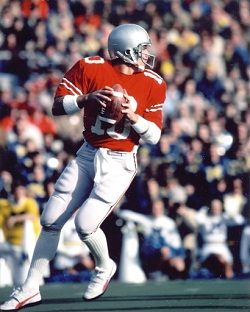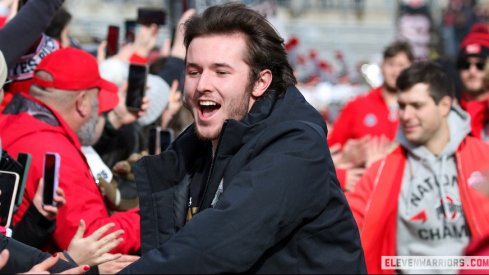This is bye week, which means no opportunity for an opponent flashback. So I thought I would take an opportunity to address some things that have come up in recent weeks, especially as the season has gone in a direction few of us foresaw. The up-and-down nature of 2011 in football has caused some fans to react to what seems like strange behavior by the team.
The recent victory against Illinois, however refreshing, was a source of angst for many fans and continues to be so due to the lack of a passing attack. Also, seeing the starting QB throw balls that are not exactly a tight spiral has brought some snarky comments from the broadcast booth and many fan comments as well. Finally, the predictable nature of the offense is drawing criticism, some of it warranted, some not.
Looking back over almost 40 years of observing OSU football and football in general, there's not much I haven't seen in the game. Everything we are seeing now has a precedent, some of them several, and so none of it is all that troubling to me. I thought maybe if I had a chance to talk about some of this stuff in detail it might calm some nerves and help put things into perspective. Unfortunately, there's nothing I can do about the Bob Davies of the world, so use of the mute button might be necessary for a while.
THE GROUNDED OFFENSE
The first thing I want to clear up is the state of the offense. Yes, it is true that OSU threw only 4 passes on Saturday. What is not true is that the offense is forced into this situation because Braxton Miller cannot throw the ball. Bob Davie alluded to this during the broadcast, but he has not done his homework on the promising freshman. In fact, Miller is a much more polished passer than Terelle Pryor was at this stage in his career, and viewing a few of his recruiting videos demonstrates that clearly.
Nevertheless, some might be dismayed by the idea of running so much and passing so little. There are three points I would like to make about this one game. First, the game situation warranted it for a couple reasons. Second, it was one game, and a temporary suspension of the passing game is has some precedent at OSU. Third, having a productive running game is more important than having a dazzling passing attack.
Many commentators and fans have discussed the fact that Miller was still favoring the ankle, and that the wind dictated part of the decision to run. This is all true, but there's one more reason OSU passed very little on Saturday: they never trailed in the game. When you factor in the amount of futility the OSU offense has produced this season, then give them a 3-0 lead on the road in a windy stadium with a banged-up freshman QB, the decision to run almost exclusively makes more sense.
During their first drive, OSU was against the wind, and so it did not make sense to throw if throwing was unnecessary. And it was unnecessary for most of that first drive. The 3rd and long they faced right before kicking the FG was an obvious passing situation, and this is where I think th coaches can be accused of being a little conservative for calling a QB draw. But after that, and especially after getting an INT and running it in for a 12-yard TD on their first play of the 2nd half, you can understand why the coaches felt it was unnecessary to throw for the rest of the game. If Illinois had threatened their lead, I think you would have seen more of OSU passing, but Illinois didn't threaten until late, and so passing was an unnecessary risk.
Another thing to remember is that this is most likely a temporary situation. And for this, it helps to have a grasp of history. Back in 1989, Coach John Cooper thought that his offense was getting a little too sloppy and his offensive line was having trouble with the complicated schemes run by offensive coordinator Jim Colletto. The team was 2-2 and had been embarrassed by Illinois in a 20-point road loss. So, with an excellent Indiana squad (roll that around in your brain) coming to Columbus in week 5, Cooper made a radical move.
As I described in a post more than 2 years ago, Ohio State defeated Indiana on a perfect day in Columbus by running almost exclusively out of a formation where they had 2 tight ends and a fullback with only 1 WR. They threw only 6 passes that day (completing 5), and won the game 35-31. Indiana won the yardage battle 444-290, but lost on the scoreboard, which goes to my third point that running is more important than passing.
A team that passes well will typically move the ball with ease between the 20's but will sometimes stall out in the red zone without a good running offense. But a team that blocks well in the rushing game will wear down the defense and typically is extremely efficient in the red zone. It also helps to have a great defense, which OSU does. You can have a great passing offense but if your defense is pourous it may not matter. On November 8, 1980, Illinois QB Dave Wilson set a new NCAA single-game record by passing for 621 yards and 6 TD's against Ohio State. Nevertheless, OSU won that game 49-42 because they went up and down the field at will against Illinois' defense all day.
 Schlichter: the king of the flutterball.
Schlichter: the king of the flutterball.THE FLUTTERBALL AND PREDICTABILITY
I've heard quite a bit from my friends about the fact that Braxton Miller does not throw a pretty pass. Announcers have remarked on this as well (as have our writers). Still, the TD pass to Jake Stoneburner on Saturday was a laser that found the target with ease. Can he throw a spiral? He's thrown a lot of them, but it's the wobblers that seem to get all the attention. This is unfortunate, and unnecessary.
What really matters is not whether the pass looks good, but whether it hits the target or not. OSU legend Art Schlichter threw a wobbly ball for most of his career at Ohio State, tightening up the spiral only during his senior year. The typical Schlichter flutterball of 1979 did not prevent him from being named 1st team All-American as a sophomore and leading his team to an undefeated regular season. In the bowl game against USC, Schlichter flutterballed his way to over 280 yards passing against a great secondary.
An NFL QB who was famous for throwing wobblers was Billy Kilmer. In fact, the ugliness of his passes was one reason many Washington Redskin fans preferred his rival Sonny Jurgenson. But Kilmer led the Redskins to the Super Bowl in 1972 and was named All-Pro that season. In all, he played 18 years in the NFL and passed for over 20,000 yards, all without ever losing the wobble in his passes. I think people need to back off of Braxton Miller on this point. If he makes good decisions with the ball and gets it where it needs to be, he can throw the flutterball all he wants. Accuracy is the main thing.
The last thing I want to address is predictability. I've been as critical of coach Bollman as anyone has, but I don't think it's always a bad thing to be predictable. There is no question that when you line up with two tight ends and a fullback, you are broadcasting the run to your opponent. But if you block the play, does it really matter that they knew what was coming? Not at all. If you knock them on their rear-ends, they won't be able to stop you.
Legendary San Diego Chargers coach Don Coryell (the architect of the "Air Coryell" offense) used to say "we're going to throw and I don't care who knows it". On the other hand, former Rams and Seahawks coach Chuck Knox was so predictable they used to call him "Ground Chuck" because his teams would do little more than run. What both coaches had in common besides predictable offenses was winning, and they did it at the highest level. Still, Ohio State covets a balanced offense, and I believe they will ultimately get there. But in the meantime, a little predictability is not a bad thing as long as it accompanies winning.

